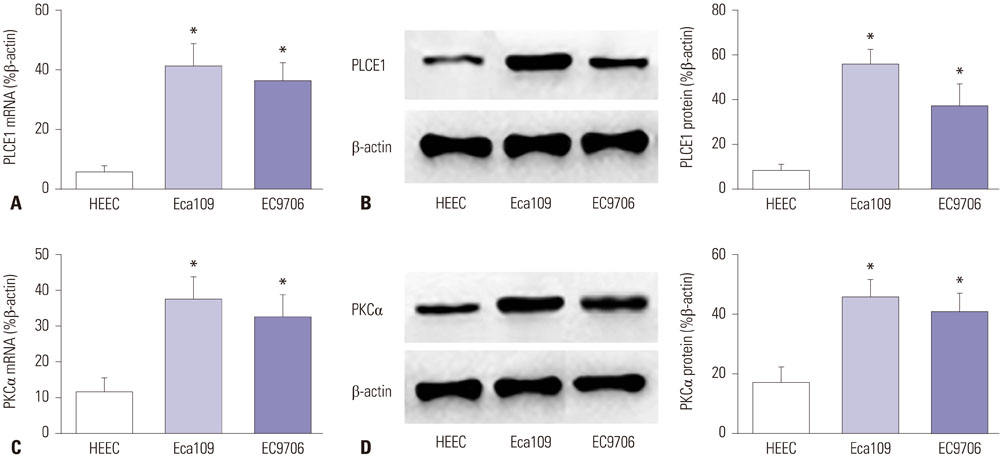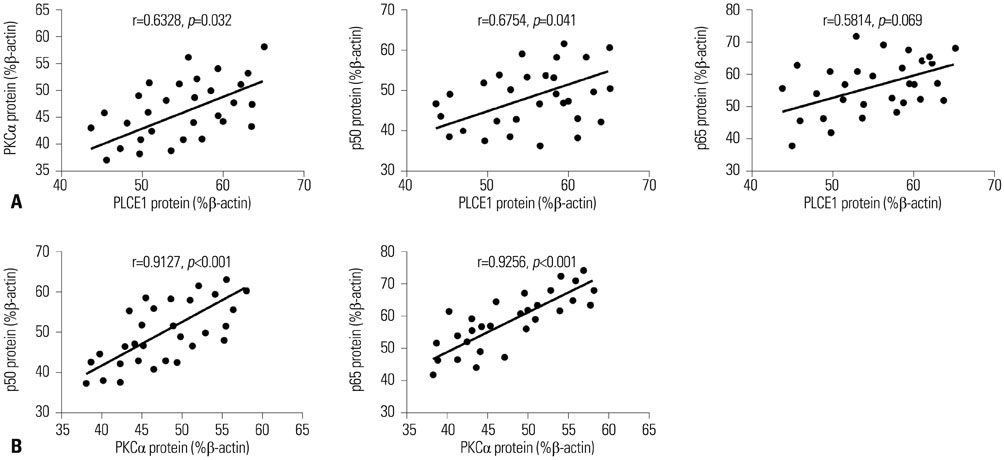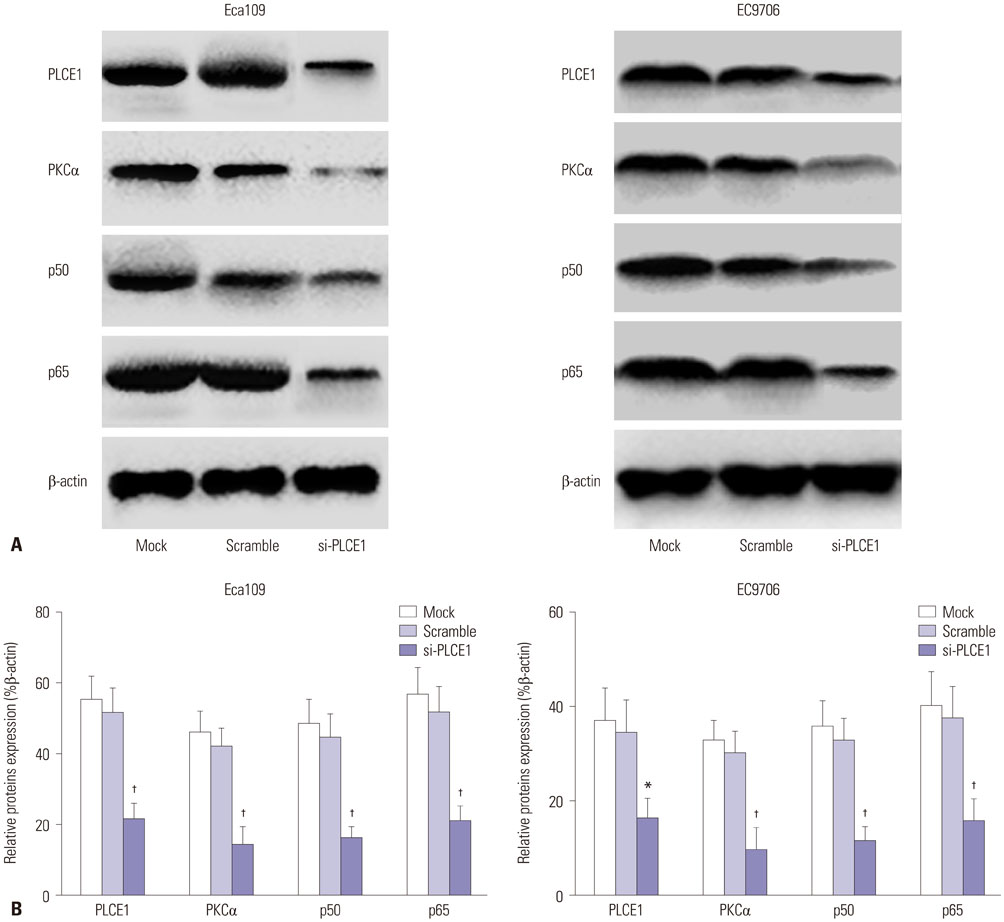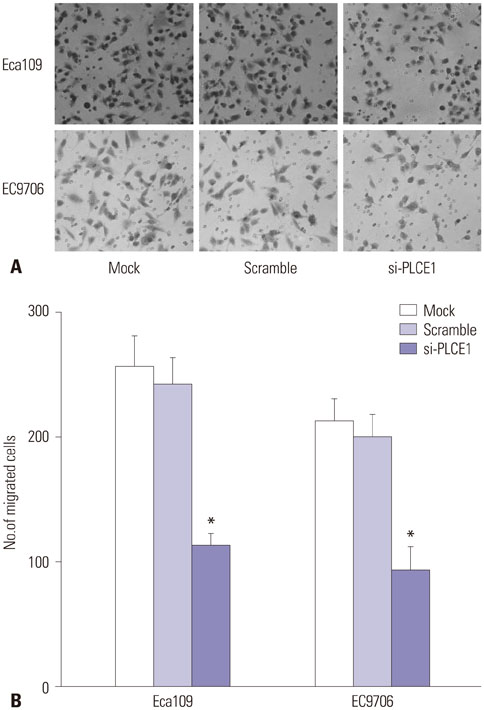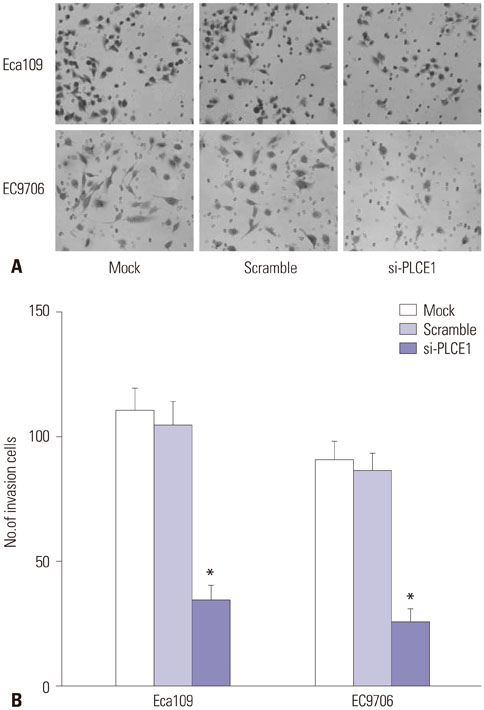Yonsei Med J.
2018 Dec;59(10):1159-1165. 10.3349/ymj.2018.59.10.1159.
PLCE1 Promotes the Invasion and Migration of Esophageal Cancer Cells by Up-Regulating the PKCα/NF-κB Pathway
- Affiliations
-
- 1Department of Gastroenterology, Weifang Yidu Central Hospital, Weifang, Shandong, China. liyongzhu289@163.com
- KMID: 2426329
- DOI: http://doi.org/10.3349/ymj.2018.59.10.1159
Abstract
- PURPOSE
To investigate the effect and mechanism of phospholipase C epsilon gene 1 (PLCE1) expression on esophageal cancer cell lines.
MATERIALS AND METHODS
The esophageal carcinoma cell lines Eca109 and EC9706 and normal esophageal epithelial cell line HEEC were cultured. The expression of PLCE1, protein kinase C alpha (PKCα), and nuclear factor kappa B (NF-κB) p50/p65 homodimer in cells were comparatively analyzed. The esophageal cancer cells were divided into si-PLCE1, control siRNA (scramble), and mock groups that were transfected with specific siRNA for PLCE1, control siRNA, and blank controls, respectively. Expression of PLCE1, PKCα, p50, and p65 was detected by Western blotting. Transwell assay was used to detect migration and invasion of Eca109 and EC9706 cells.
RESULTS
Compared with HEEC, the expression of PLCE1, PKCα, p50, and p65 was increased in Eca109 and EC9706 cells. The expression of PLCE1 was positively correlated with the expression of PKCα and p50 (PKCα: r=0.6328, p=0.032; p50: r=0.6754, p=0.041). PKCα expression had a positive correlation with the expression of p50 and p65 (p50: r=0.9127, p=0.000; p65: r=0.9256, p=0.000). Down-regulation of PLCE1 significantly decreased the expression of PKCα and NF-κB-related proteins (p65: p=0.002, p=0.004; p50: p=0.005, p=0.009) and inhibited the migration and invasion of Eca109 and EC9706 cells.
CONCLUSION
PLCE1 activated NF-κB signaling by up-regulating PKCα, which could promote invasion and migration of esophageal cancer cells.
Keyword
MeSH Terms
Figure
Reference
-
1. Yang Q, Lin W, Liu Z, Zhu J, Huang N, Cui Z, et al. RAP80 is an independent prognosis biomarker for the outcome of patients with esophageal squamous cell carcinoma. Cell Death Dis. 2018; 9:146.
Article2. Zhang M, Zhang L, Cui M, Ye W, Zhang P, Zhou S, et al. miR-302b inhibits cancer-related inflammation by targeting ERBB4, IRF2 and CXCR4 in esophageal cancer. Oncotarget. 2017; 8:49053–49063.
Article3. Wang LD, Zhou FY, Li XM, Sun LD, Song X, Jin Y, et al. Genome-wide association study of esophageal squamous cell carcinoma in Chinese subjects identifies susceptibility loci at PLCE1 and C20orf54. Nat Genet. 2010; 42:759–763.4. Abnet CC, Freedman ND, Hu N, Wang Z, Yu K, Shu XO, et al. A shared susceptibility locus in PLCE1 at 10q23 for gastric adenocarcinoma and esophageal squamous cell carcinoma. Nat Genet. 2010; 42:764–767.
Article5. Wang ZJ, Wang DX, Wang ZG, Pathology DO, Hospital ZP, Pediatrics DO. Expression of PLCE1 and p53 in colorectal cancer and its significance. J Clin Exp Med. 2018; 3:247–251.6. Cheng H, Luo C, Wu X, Zhang Y, He Y, Wu Q, et al. shRNA targeting PLCε inhibits bladder cancer cell growth in vitro and in vivo. Urology. 2011; 78:474.e7–474.e11.7. Chen H, Zhao J, Ji F. The progress of correlation research about PLCE1 gene and gastric cancer occurrence. J Modern Oncol. 2016; 24:2160–2162.8. Jomrich G, Paireder M, Gleiss A, Kristo I, Harpain L, Schoppmann SF. Comparison of inflammation-based prognostic scores in a cohort of patients with resectable esophageal cancer. Gastroenterol Res Pract. 2017; 2017:1678584.
Article9. Lu Z, Long Y, Cun X, Wang X, Li J, Mei L, et al. A size-shrinkable nanoparticle-based combined anti-tumor and anti-inflammatory strategy for enhanced cancer therapy. Nanoscale. 2018; 10:9957–9970.
Article10. Long L, Pang XX, Lei F, Zhang JS, Wang W, Liao LD, et al. SLC52A3 expression is activated by NF-κB p65/Rel-B and serves as a prognostic biomarker in esophageal cancer. Cell Mol Life Sci. 2018; 75:2643–2661.
Article11. Zhao HW, Cui YF, Jiang JZ, Che N, Jing YE, Wang CY, et al. [Sesamin suppresses mast cell activation through inhibition of PKCα/NF-κB signaling pathway]. Zhongguo Mian Yi Xue Za Zhi. 2018; 2:167–171.12. Racchi M, Buoso E, Ronfani M, Serafini MM, Galasso M, Lanni C, et al. Role of hormones in the regulation of RACK1 expression as a signaling checkpoint in immunosenescence. Int J Mol Sci. 2017; 18:1453.
Article13. Song T, Zheng YM, Vincent PA, Cai D, Rosenberg P, Wang YX. Canonical transient receptor potential 3 channels activate NF-κB to mediate allergic airway disease via PKC-α/IκB-α and calcineurin/IκB-β pathways. FASEB J. 2016; 30:214–229.
Article14. Gu H, Ding G, Zhang W, Liu C, Chen Y, Chen S, et al. Replication study of PLCE1 and C20orf54 polymorphism and risk of esophageal cancer in a Chinese population. Mol Biol Rep. 2012; 39:9105–9111.
Article15. Guo LY, Yang N, Hu D, Zhao X, Feng B, Zhang Y, et al. PLCE1 rs2274223 polymorphism and susceptibility to esophageal cancer: a meta-analysis. Asian Pac J Cancer Prev. 2014; 15:9107–9112.
Article16. Cui XB, Li S, Li TT, Peng H, Jin TT, Zhang SM, et al. Targeting oncogenic PLCE1 by miR-145 impairs tumor proliferation and metastasis of esophageal squamous cell carcinoma. Oncotarget. 2016; 7:1777–1795.
Article17. Li Y, An J, Huang S, Liao H, Weng Y, Cai S, et al. PLCE1 suppresses p53 expression in esophageal cancer cells. Cancer Invest. 2014; 32:236–240.
Article18. Zhai S, Liu C, Zhang L, Zhu J, Guo J, Zhang J, et al. PLCE1 promotes esophageal cancer cell progression by maintaining the transcriptional activity of snail. Neoplasia. 2017; 19:154–164.
Article19. Zhao L, Wei ZB, Yang CQ, Chen JJ, Li D, Ji AF, et al. Effects of PLCE1 gene silencing by RNA interference on cell cycling and apoptosis in esophageal carcinoma cells. Asian Pac J Cancer Prev. 2014; 15:5437–5442.
Article20. Zhang B, Liu T, Zhou H. [The promoting research of phospholipase C epsilon-1 on nasal Th2 cell polarization]. Lin Chung Er Bi Yan Hou Tou Jing Wai Ke Za Zhi. 2014; 28:1363–1366.21. Li J, Li Y, Wang B, Ma Y, Chen P. Id-1 promotes migration and invasion of non-small cell lung cancer cells through activating NF-κB signaling pathway. J Biomed Sci. 2017; 24:95.
Article22. Che R, Zhang A. Mechanisms of glucocorticoid resistance in idiopathic nephrotic syndrome. Kidney Blood Press Res. 2013; 37:360–378.
Article23. Ordoñez-Moreno A, Rodriguez-Monterrosas C, Cortes-Reynosa P, Perez-Carreon JI, Perez Salazar E. Erythropoietin induces an epithelial to mesenchymal transition-like process in mammary epithelial cells MCF10A. J Cell Biochem. 2017; 118:2983–2992.
Article24. Mao M, Cai L, Hu J, Hu L. Investigating the migration and invasion of human squamous cervical carcinoma line Siha stimulated by TGF-β1 and its underlying mechanisms. Chin J Cell Biol. 2015; 1:59–65.25. Cui XB, Pang XL, Li S, Jin J, Hu JM, Yang L, et al. Elevated expression patterns and tight correlation of the PLCE1 and NF-κB signaling in Kazakh patients with esophageal carcinoma. Med Oncol. 2014; 31:791.
Article26. Hsieh YH, Wu TT, Tsai JH, Huang CY, Hsieh YS, Liu JY. PKCalpha expression regulated by Elk-1 and MZF-1 in human HCC cells. Biochem Biophys Res Commun. 2006; 339:217–225.27. Lahn M, Paterson BM, Sundell K, Ma D. The role of protein kinase C-alpha (PKC-alpha) in malignancies of the gastrointestinal tract. Eur J Cancer. 2004; 40:10–20.
Article28. van der Vorst EPC, Theodorou K, Wu Y, Hoeksema MA, Goossens P, Bursill CA, et al. High-density lipoproteins exert pro-inflammatory effects on macrophages via passive cholesterol depletion and PKC-NF-κB/STAT1-IRF1 signaling. Cell Metab. 2017; 25:197–207.
- Full Text Links
- Actions
-
Cited
- CITED
-
- Close
- Share
- Similar articles
-
- Exosome-mediated lnc-ABCA12-3 promotes proliferation and glycolysis but inhibits apoptosis by regulating the tolllike receptor 4/nuclear factor kappa-B signaling pathway in esophageal squamous cell carcinoma
- LETM1 Promotes Gastric Cancer Cell Proliferation, Migration, and Invasion via the PI3K/Akt Signaling Pathway
- The Major Role of NF-κB in the Depth of Invasion on Acral Melanoma by Decreasing CD8⺠T Cells
- IKKγ Facilitates the Activation of NF-κB by Hepatitis C Virus Core Protein
- Doxorubicin Promotes Migration and Invasion of Breast Cancer Cells through the Upregulation of the RhoA/MLC Pathway

